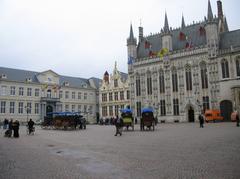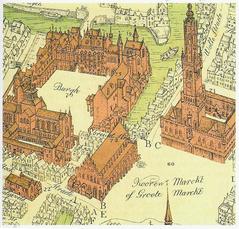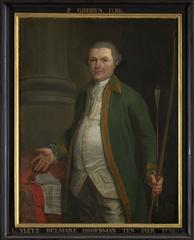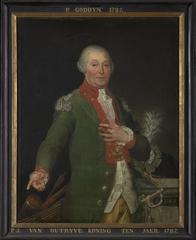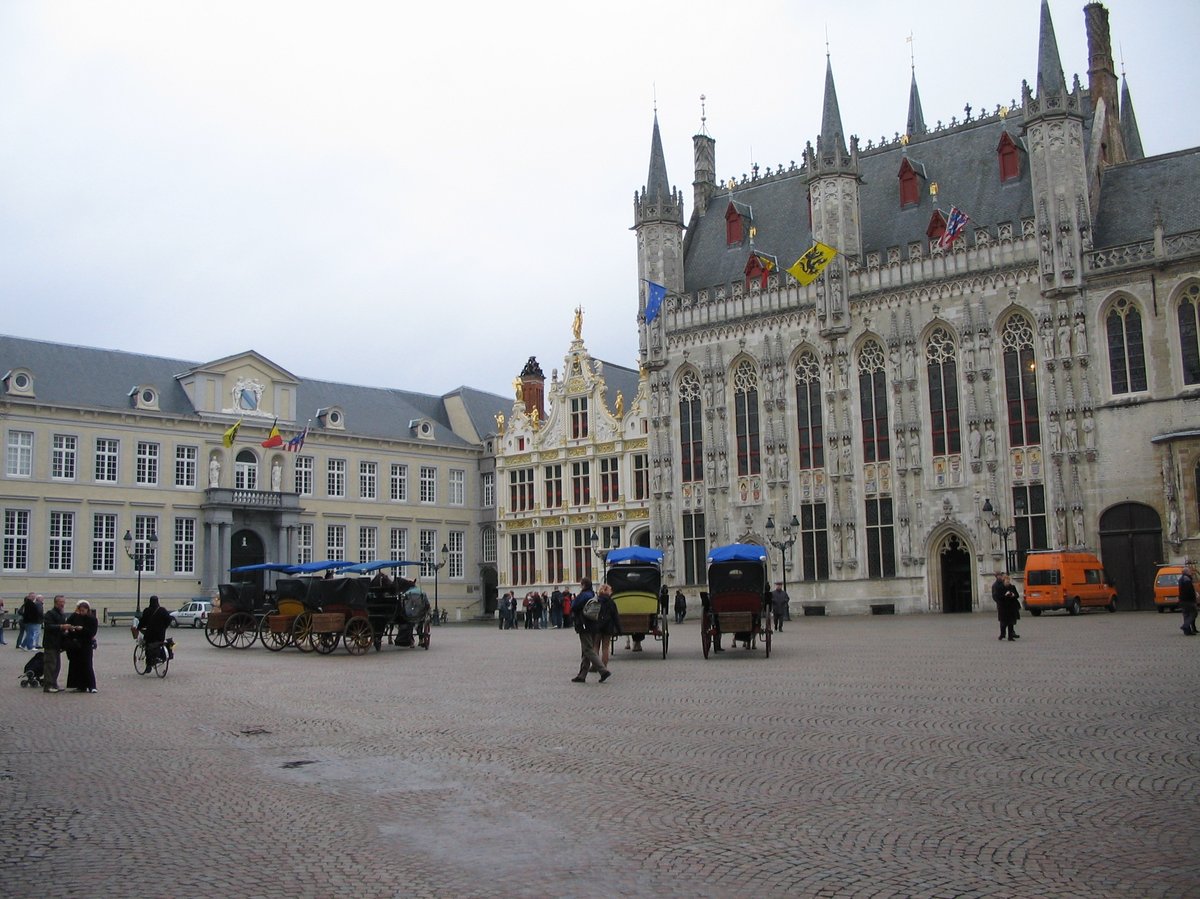
Bruges City Hall: Visiting Hours, Tickets, and Historical Significance Guide
Date: 15/06/2025
Introduction
Bruges City Hall (Stadhuis van Brugge), located on the picturesque Burg Square, stands as one of the oldest and most splendid municipal buildings in the Low Countries. Built between 1376 and 1421 at the height of Bruges’ medieval prosperity, it reflects the city’s former status as a major trading hub and its enduring civic pride. With its stunning Brabantine Gothic architecture, richly adorned façade, and vibrant historical role, Bruges City Hall continues to serve as the seat of city government and an essential destination for visitors eager to explore the city’s heritage (Musea Brugge, Visit Bruges, Adventure Backpack).
This comprehensive guide provides everything you need—from visiting hours and ticket details to architectural highlights, accessibility, and nearby attractions—ensuring a rewarding visit to this iconic monument.
Fast Facts
- Location: Burg 12, 8000 Brugge, Belgium
- UNESCO Status: Part of the Historic Centre of Bruges
- Architectural Style: Brabantine Gothic
- Construction: 1376–1421
- Current Use: Municipal government, museum, civil ceremonies
Historical Overview
Origins and Construction
Bruges City Hall was constructed between 1376 and 1421, replacing the earlier Ghyselhuus (a former jail where the city council met after a fire destroyed the Belfry’s upper floors in 1280). The foundation stone was laid by Count Louis of Flanders, with Jan Roegiers overseeing the project. This period marked Bruges’ “Golden Age,” when the city thrived as a commercial power in the Burgundian Netherlands (art-facts.com).
Civic and Political Role
For over six centuries, Bruges City Hall has been the administrative heart of the city. It continues to host the mayor’s office, council meetings, and civil ceremonies, maintaining its political and civic importance (Musea Brugge).
Artistic and Architectural Evolution
The late-Gothic façade, characterized by verticality, pointed arches, ornate tracery, and 47 statues of historical and legendary figures (restored after the French Revolution), became a model for town halls in Brussels and Ghent. Inside, the grand Gothic Hall features a double-vaulted timber ceiling, biblical medallions, 19th-century murals by Albrecht De Vriendt, and stained glass windows—the result of neo-Gothic restorations in the late 19th and early 20th centuries (adventurebackpack.com).
Architectural Highlights
- Façade: A masterpiece of Brabantine Gothic style, adorned with statues, pinnacles, and heraldic emblems (art-facts.com).
- Gothic Hall: The first-floor council chamber features a soaring vaulted wooden ceiling, murals depicting Bruges’ history, and stained glass windows.
- Interior Exhibits: Life-sized portraits, period furnishings, and exhibits on Bruges’ maritime and trading history contribute to an immersive visitor experience.
- Structural Innovations: The use of stone vaulting and buttresses allowed larger windows, filling interiors with light—an architectural advancement for its time.
Visiting Bruges City Hall
Opening Hours
- Daily: 9:30 a.m. – 5:00 p.m. (last admission 4:30 p.m.)
- Exceptions: Closed on January 1 and December 25. Access may be restricted during municipal council meetings (last Monday of each month except July), weddings (Tuesdays, Fridays, Saturdays), or special events. Always confirm current hours before visiting (Musea Brugge).
Tickets and Admission
- Standard Adult Ticket: €8
- Seniors (65+), Youth (13–25): Reduced rates
- Children under 13: Free
- Musea Brugge Card / Museumpassmusées Holders: Free or discounted entry
- Weekend Ticket: Includes entry to Brugse Vrije (Liberty of Bruges)
- Weekday Ticket: Valid for 7 days; allows free weekend entry to Brugse Vrije
Purchase tickets at the entrance or online via the official Bruges tourism website.
Guided Tours and Digital Guides
- Guided Tours: Available in multiple languages, providing in-depth exploration of the City Hall’s history, art, and architecture.
- Digital Guide: The MB Explorer app enhances your visit with detailed commentary and images (bring your own headphones) (Musea Brugge).
Accessibility
- Wheelchair Accessibility: Most areas are accessible; some historic rooms may have steps or uneven floors. Contact ahead for assistance.
- Facilities: Public toilets (for a small fee) are nearby; a museum shop offers books and souvenirs.
Visitor Guidelines
- Photography: Allowed in most areas; no flash or tripods.
- Language: Staff speak Flemish, English, French, and often German; signage and digital guides are multilingual.
- Conduct: Respect historic interiors, follow posted rules, and cooperate during restricted access periods.
Nearby Attractions
Bruges City Hall’s central location on Burg Square makes it an excellent starting point to explore Bruges’ other historic sites:
- Basilica of the Holy Blood: Houses a renowned relic and features Romanesque and Gothic architecture (Tourist Secrets).
- Brugse Vrije (Liberty of Bruges): Former courthouse with exhibits on city administration, accessible with a City Hall ticket on weekends.
- Old Civil Registry: Renaissance building with gilded sculptures.
- Belfry of Bruges and Markt Square: Offers panoramic city views and a vibrant market atmosphere.
All sites are within walking distance, making it easy to experience Bruges’ rich architectural tapestry (Thoroughly Travel).
Practical Tips for Visiting
- Best Times: Early morning or late afternoon for fewer crowds and the best light for photography.
- Stay Overnight: Bruges is quieter and more atmospheric in the evening after day-trippers leave (Next Level of Travel).
- Use Passes: The Musea Brugge Card and Museumpassmusées offer value for exploring multiple sites.
- Check Events Calendar: Confirm hours and access, especially during holidays, council meetings, or weddings.
- Contact Information: For group bookings or special assistance, call +32 50 44 87 43 or email [email protected].
Frequently Asked Questions (FAQ)
Q: What are Bruges City Hall’s visiting hours?
A: Daily 9:30 a.m. – 5:00 p.m.; closed January 1, December 25, and sometimes during events. Always check for updates.
Q: Where can I buy Bruges City Hall tickets?
A: At the entrance or online via the Musea Brugge website.
Q: Is Bruges City Hall accessible for those with limited mobility?
A: Mostly yes; contact ahead for specific needs.
Q: Are guided tours and audio guides available?
A: Yes, in multiple languages, including digital guides via QR code inside.
Q: Can I visit Bruges City Hall with a museum pass?
A: Yes, both the Musea Brugge Card and Museumpassmusées include City Hall entry.
Q: Are nearby Bruges historical sites easy to combine with a City Hall visit?
A: Absolutely—Burg Square, the Basilica of the Holy Blood, Brugse Vrije, and Markt Square are all close by.
Visuals and Media Suggestions
- High-quality exterior and interior photos with SEO-friendly alt text: “Bruges City Hall visiting hours,” “Bruges City Hall tickets,” “Bruges historical sites.”
- Map of central Bruges highlighting City Hall and nearby attractions.
- Virtual tour or video walkthrough link (if available).
Conclusion
Bruges City Hall is not just a relic of the past—it is an active center of civic life, a masterpiece of Gothic architecture, and a gateway to understanding Bruges’ vibrant history. By planning your visit around official hours and ticketing, taking advantage of guided or digital tours, and exploring nearby landmarks, you will enjoy a rewarding and memorable experience at one of Europe’s most captivating historical sites.
Stay updated on Bruges City Hall and other Bruges historical sites by following us on social media and downloading the Audiala app for the latest travel tips and audio guides. Explore related articles and plan your ideal Bruges itinerary today!
Sources
- Musea Brugge
- Musea Brugge Practical Info
- Visit Bruges
- Adventure Backpack
- art-facts.com
- WhichMuseum
- Next Level of Travel
- Tourist Secrets
- Thoroughly Travel
